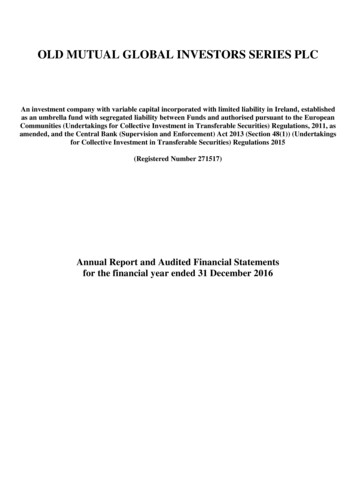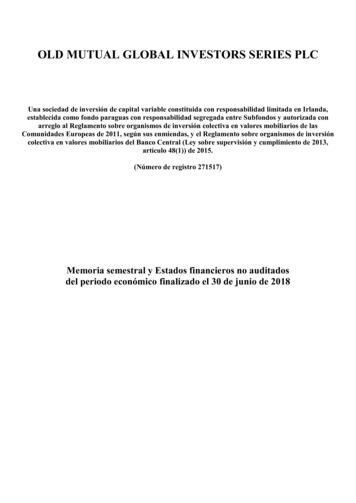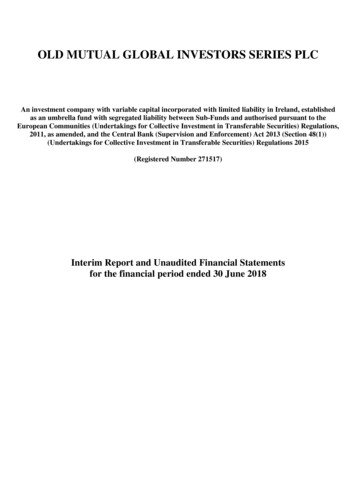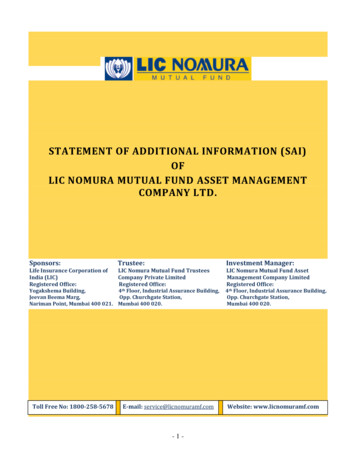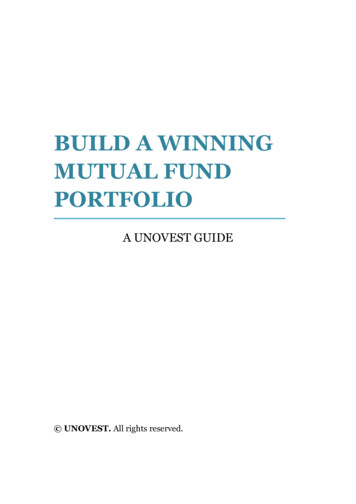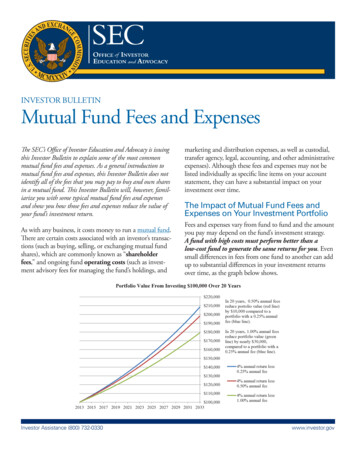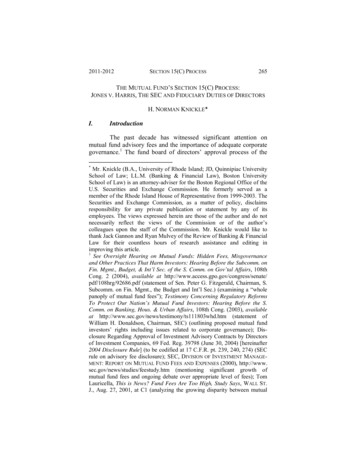
Transcription
2011-2012SECTION 15(C) PROCESS265THE MUTUAL FUND’S SECTION 15(C) PROCESS:JONES V. HARRIS, THE SEC AND FIDUCIARY DUTIES OF DIRECTORSH. NORMAN KNICKLE*I.IntroductionThe past decade has witnessed significant attention onmutual fund advisory fees and the importance of adequate corporategovernance.1 The fund board of directors’ approval process of the*Mr. Knickle (B.A., University of Rhode Island; JD, Quinnipiac UniversitySchool of Law; LL.M. (Banking & Financial Law), Boston UniversitySchool of Law) is an attorney-adviser for the Boston Regional Office of theU.S. Securities and Exchange Commission. He formerly served as amember of the Rhode Island House of Representative from 1999-2003. TheSecurities and Exchange Commission, as a matter of policy, disclaimsresponsibility for any private publication or statement by any of itsemployees. The views expressed herein are those of the author and do notnecessarily reflect the views of the Commission or of the author’scolleagues upon the staff of the Commission. Mr. Knickle would like tothank Jack Gannon and Ryan Mulvey of the Review of Banking & FinancialLaw for their countless hours of research assistance and editing inimproving this article.1See Oversight Hearing on Mutual Funds: Hidden Fees, Misgovernanceand Other Practices That Harm Investors: Hearing Before the Subcomm. onFin. Mgmt., Budget, & Int’l Sec. of the S. Comm. on Gov’tal Affairs, 108thCong. 2 (2004), available at rg/92686.pdf (statement of Sen. Peter G. Fitzgerald, Chairman, S.Subcomm. on Fin. Mgmt., the Budget and Int’l Sec.) (examining a “wholepanoply of mutual fund fees”); Testimony Concerning Regulatory ReformsTo Protect Our Nation’s Mutual Fund Investors: Hearing Before the S.Comm. on Banking, Hous. & Urban Affairs, 108th Cong. (2003), availableat http://www.sec.gov/news/testimony/ts111803whd.htm (statement ofWilliam H. Donaldson, Chairman, SEC) (outlining proposed mutual fundinvestors’ rights including issues related to corporate governance); Disclosure Regarding Approval of Investment Advisory Contracts by Directorsof Investment Companies, 69 Fed. Reg. 39798 (June 30, 2004) [hereinafter2004 Disclosure Rule] (to be codified at 17 C.F.R. pt. 239, 240, 274) (SECrule on advisory fee disclosure); SEC, DIVISION OF INVESTMENT MANAGEMENT: REPORT ON MUTUAL FUND FEES AND EXPENSES (2000), http://www.sec.gov/news/studies/feestudy.htm (mentioning significant growth ofmutual fund fees and ongoing debate over appropriate level of fees); TomLauricella, This is News? Fund Fees Are Too High, Study Says, WALL ST.J., Aug. 27, 2001, at C1 (analyzing the growing disparity between mutual
266REVIEW OF BANKING & FINANCIAL LAWVol. 31investment advisory fee and contract is the cornerstone of the fundgovernance mandate set forth in the Investment Company Act of1940 (the “1940 Act”)2. The 1940 Act creates both specific andgeneral fiduciary duties for investment advisers and fund directors.These duties have recently received heightened scrutiny from boththe Securities and Exchange Commission (the “SEC” or the“Commission”) and mutual fund shareholders.3 Recent activityreflecting such heightened scrutiny includes SEC rule-making,increased enforcement attention and the Supreme Court’s 2010fund management fees and pension fund management fees); Press Release,Office of N.Y. State Att’y Gen., Statement by Attorney General EliotSpitzer Regarding Mutual Fund Fee Reduction (Dec. 18, 2003), http://www.ag.ny.gov/media center/2003/dec/dec18d 03.html (describing mutual fundfees as part of the “root cause” of harm to investors).2See 15 U.S.C. § 80a-1 (1940); ROBERT ROBERTSON, FUND GOVERNANCE:LEGAL DUTIES OF INVESTMENT COMPANY DIRECTORS 6-3 (2011) (“One ofthe board’s most important duties is approving . . . the advisoryagreement.”).3See, e.g., John P. Freeman & Stewart L. Brown, Mutual Fund AdvisoryFees: The Cost of Conflicts of Interest, 26 J. CORP. L. 609, 611-13 (20002001) (discussing heightened scrutiny from the SEC, press, academics, andother interested parties over mutual funds’ fee and corporate governancestructure); Perils in the savings pool – Mutual funds, ECONOMIST, Nov. 8,2003, at 65 (arguing that fund boards tend to “rubber-stamp” their advisers’contracts without question). See generally Jones v. Harris Assoc. L.P., 130S. Ct. 1418 (2010) (clarifying the standard to determine whether an investment advisor violated a fiduciary duty regarding fees paid by an investmentfund); Value Line, Inc., Securities Act Release No. 9081, Exchange ActRelease No. 60,936, Investment Company Act Release No. 28,989, 2009WL 3652408 (Nov. 4, 2009), available at df (instituting sanctions and cease and desist order inrelation to undisclosed brokerage commission payments to a broker-dealeraffiliated with investment adviser); N. Y. Life Inv. Mgmt. LLC, InvestmentAdvisors Act Release No. 2883, Investment Company Act Release No.28747, 2009 WL 1480831 (May 27, 2009), available at df (imposing sanctions and relatedcease and desist order related to advisory contracts); Jeffrey J. Haas &Steven R. Howard, The Heartland Funds’ Receivership and Its Implicationsfor Independent Mutual Fund Directors, 51 EMORY L.J. 153 (2002)(examining the lessons learned from the collapse of the Heartland MutualFund); Alan R. Palmiter, The Mutual Fund Board: A Failed Experiment inRegulatory Outsourcing, 1 BROOK J. CORP. FIN. & COM. L. 165 (2006)(arguing that fund directors fail to adequately oversee fund advisors).
2011-2012SECTION 15(C) PROCESS267decision in Jones v. Harris4 to overturn the Seventh Circuit’schallenge of the standard-bearing case, Gartenberg v. Merrill Lynch.5This article explores significant issues pertaining to theinvestment advisory contract approval process, or the “15(c)process,” named after the key operative section of the 1940 Act. Thisincludes an examination of the fiduciary duties of fund directors andinvestment advisers, the so-called “Gartenberg factors” that drive theprocess, and recent attention by the SEC on mutual fund advisor fees.The article begins with a summary of the 15(c) process asmandated by the 1970 amendments to the 1940 Act, as well as theGartenberg and Jones cases.6 Next, the article provides a survey ofimportant SEC and private actions that have brought a level ofattention to the 15(c) process not seen since the congressionalhearings leading up to the passage of the 1970 amendments. Thearticle concludes with an in-depth analysis of the importantobligations of fund directors during the 15(c) process.II.Advisory Contract Approval ProcessA.History—The 1970 AmendmentsThe contemporary statutory genesis of the 15(c) processbegan with the 1970 amendments to the 1940 Act, wherein Congresscreated a new Section 15(c), and divided Section 36 into twosubsections: 36(a) on general fiduciary duties, and 36(b) on fiduciaryduty with respect to fees paid by the fund.74See Jones,130 S. Ct. at 1426 (“[W]e conclude that Gartenberg was correct. . . to face liability under § 36(b), an investment adviser must charge a feethat is so disproportionately large that it bears no reasonable relationship tothe services rendered and could not have been the product of arm’s lengthbargaining.”).5See Gartenberg v. Merrill Lynch Asset Mgmt., Inc., 694 F.2d 923, 928 (2dCir. 1982) (“To be guilty of a violation of §36(b) . . . the adviser-mangermust charge a fee that is so disproportionately large that it bears noreasonable relationship to the services rendered and could not have been theproduct of arm’s-length bargaining.”).6Investment Company Amendments Act of 1970, Pub. L. No. 91-547, 84Stat. 1413 (1970) [hereinafter 1970 Amendments].7Id. §§ 8, 20, 84 Stat. at 1419-20, 1428-30 (amending Section 15(c) andSection 36 of the Investment Company Act of 1940).
268REVIEW OF BANKING & FINANCIAL LAWVol. 31The 1960s were a boom time for the mutual fund industrywith assets under management increasing significantly.8 With thisburst of success, however, elected officials and fund shareholdersbegan questioning whether fund advisers had an obligation to sharethat success with shareholders through lower fees. The more intensescrutiny reflected the suspicion that investment advisers’ control andinfluence over their sponsored funds was nearly total and reflected arelationship of “business incest.”9 Thus, during the time leading up tothe 1970 amendments, elected officials and fund shareholders raisedconcerns that mutual funds’ management structure promotedexcessive advisory fees that needed to be addressed.10A key point in this movement happened in 1966, when theSEC issued a policy report citing three factors that contributed to thefailure of competitive forces influencing the advisory contract andfee approval process: (1) dependence of independent directors uponaffiliated directors for guidance on fund policy matters; (2) lack oftime and pay attributed to director duties and lack of receipt ofsufficient information from affiliated directors, especially onfundamental fund matters such as the advisory contract and fee; and(3) the practical inability to terminate or even to threaten to terminatethe advisory contract.11 In sum, at least up until 1970, the advisorycontract approval process could not be characterized as “bid-andask.”128See generally H.R. REP. NO. 89-2337 (1966) [hereinafter 1966 SECReport] (discussing implications of mutual fund growth); H.R. REP. NO. 872274 (1962) [hereinafter Wharton Report] (analyzing significant growth ofthe mutual fund industry). For an elaborate discussion of the legislativeevents leading up to the 1970 Amendments, see William J. Nutt, A Study ofMutual Fund Independent Directors, 120 U. PA. L. REV. 179 (1971)(discussing the role of independent directors in fund management).9See Note, The Mutual Fund and its Management Company: An Analysis ofBusiness Incest, 71 YALE L.J. 137 (1971) (“A recent wave of shareholderderivative actions against mutual fund directors and their managementcompanies has challenged the independence and reasonableness of certaindirectors in granting fees to the funds’ investment advisers . . . .”).10See Wharton Report, supra note 8, at 29-30 (stating that advisers chargedtheir mutual fund clients more than their other clients, and that mutualfunds, unlike those other clients, lacked the bargaining power to properlynegotiate for fees).111966 SEC Report, supra note 8, at 148.12Nutt, supra note 8, at 223 (“Contract renewal is not a bid-and-askproposition.”).
2011-2012SECTION 15(C) PROCESS269One commentator has suggested that Saxe v. Brady, aprominent case on the issue decided in 1962, “all but immunized”directors from liability for allowing the adviser to overchargeadvisory fees.13 In other words, the case stood for the proposition thatfees were not excessive if fully disclosed, ratified by shareholdersand in line with industry averages.14 This case may have promptedboth the SEC and Congress to push for a less stringent standard forproving fees were inappropriately excessive.The SEC initially recommended that Congress draft a bill in1967 that would have amended §15 of the 1940 Act to require thatfees be “reasonable.”15 The Investment Company Institute (“ICI”)strongly opposed the bill claiming the reasonableness standard wasstricter than a fiduciary standard and would allow the courts toengage in rate-making over fund fees.16The proposed 1967 bill also enumerated standards similar tothe factors that the Court eventually outlined in Gartenberg.17 The13Cynthia L. Kahn, Direct not Derivative: Recovering Excessive InvestmentAdvisor Fees in Mutual Funds, 71 GEO. L.J. 1595, 1609 n.84 (1983)(“Under Saxe shareholder ratification of the advisory contract all but immunized advisory fees from judicial scrutiny . . . .”). See generally Saxe v.Brady, 184 A.2d 602, 605 (Del. Ch. 1962) (discussing the effect ofratification on plaintiff’s claim); Comments, Duties of the IndependentDirector in Open-End Mutual Funds, 70 MICH. L. REV. 696, 704 (1972)(“This test effectively precluded a finding that fees were excessive . . . .”).14See Saxe, 184 A.2d at 602 (finding fee not excessive when the contractwas ratified by the shareholders, and the fee was “commercially realistic”and disclosed to shareholders); 1966 SEC Report, supra note 8, at 135-37(discussing required showings for a claim of excessive management fees).The rationale of the Saxe Court appears ironically similar to that of theSeventh Circuit in Jones.15S. 1659, 90th Cong. § 8(d) (1st Sess. 1967) (requiring directors toestablish that advisory contracts were reasonable); H.R. 9510, 90th Cong.§8 (d) (1st Sess. 1967) (requiring directors to establish that advisory feeswere reasonable).16See Brief for the United States as Amicus Curiae Supporting Petitioners,Jones v. Harris, 130 S. Ct. 1418 (2009) (No. 08-586), 2009 WL 2564712;Nutt, supra note 8, at 187 (mentioning that the potential for judicial ratemaking was one of the industry’s objections to a reasonableness standard).17S. 1659, supra note 15, at 20 (“[T]he factors considered shall include . . .nature and extent of services . . . quality of services . . . .”); cf. Gartenberg v.Merrill Lynch Asset Mgmt., Inc., 694 F.2d 923, 930 (2d Cir. 1982)(declaring the “nature and quality of services” as a factor in determiningwhether fees are excessive).
270REVIEW OF BANKING & FINANCIAL LAWVol. 31original draft of the bill focused on directors and fees, unlike the finalbill, which focused on the adviser. Congress apparently removed thefactors because they were intended to be non-exclusive, not becausethey were irrelevant.18 The eventual incorporation of the factors intothe Gartenberg court’s analysis of the 15(c) process supports thatview.19The argument over reasonableness versus fiduciary duty, asGartenberg eventually noted, was primarily semantic.20 That is, if thefees were not reasonable, then they would apparently constitute abreach of fiduciary duty. The original factors from the 1967 billprovided guidance for when the fees were unreasonable.21By 1970, congressional focus was on mandating that theadviser furnish material information to the directors, requiring thatdirectors evaluate the information provided, and creating a fiduciaryduty on the adviser in connection with the fee charged.22 The18See Nutt, supra note 8, at 261 (“The broker affiliate’s cost of operationand the division of its profits are important, but not exclusive factors to beweighed by independent directors.”).19See Gartenberg, 694 F.2d at 929-30 (summarizing the relevant fund andindustry specific factors weighed by the court to determine whether the feewas excessive).20Id. at 928 (“[T]he legislative history of §36(b) indicates that the substitution of the term ‘fiduciary duty’ for ‘reasonable’ . . . was a more semanticalthan substantive compromise . . . .”); see Wharton Report, supra note 8, at144.21These factors included: (A) [t]he nature and extent of the service to beprovided . . . ; (B) [t]he quality of the service theretofore rendered to suchinvestment company . . ., or, if no such services have been theretoforerendered, the quality of the services rendered to other investment clients, ifany . . . ; (C) [t]he extent to which the compensation . . . takes in accounteconomies attributable to the growth and size of such investment company. . . given due consideration to the extent to which such economies arereflected in the charges made or compensation received for investmentadvisory services and other services provided to investment companieshaving no investment adviser . . . ; (D) [t]he value of all [non-compensatory]benefits . . . directly or indirectly received or receivable by the . . . investment adviser by reason of his relationship to such investment company;[and,] (E) [s]uch other factors as are appropriate and material. S. 1659, 90thCong., 1st. Sess. § 8(d) (1967).22Congress also concluded, “that the shareholders should not have to ‘relysolely on the fund’s directors to assure reasonable adviser fees, notwithstanding the increased disinterestedness of the board.’” Kamen v. KemperFin. Servs., Inc., 500 U.S. 90, 108 (1991) (quoting Daily Income Funds, Inc.
2011-2012SECTION 15(C) PROCESS271amendments, which eventually became law, allowed Congress toaddress both the Saxe standard and the troublesome communicationproblems that existed between the independent directors and theaffiliated ones. The 1969 congressional report states that the directorshave fiduciary duties in all affairs of the fund, especially themanagement fee, thereby officially linking the 1970 amendments forpurposes of Sections 15 and 36.23 The final version of §15(c)provides, in pertinent part:(c) [I]t shall be unlawful for any registered investment company having a board of directors to enterinto, renew, or perform any contract or agreement,written or oral, whereby a person undertakes regularly to serve or act as investment adviser of orprincipal underwriter for such company, unless theterms of such contract or agreement and any renewalthereof have been approved by the vote of a majorityof directors . . . It shall be the duty of the directors ofa registered investment company to request andevaluate, and the duty of an investment adviser tosuch company to furnish, such information as mayreasonably be necessary to evaluate the terms of anycontract whereby a person undertakes regularly toserve or act as investment adviser of suchcompany.24The final versions of §§36(a) and (b) provide, in relevantpart:v. Fox, 464 U.S. 523, 540 (1984)). Accordingly, amending the 1940 Act in1970, Congress added Section 36(b).23S. REP. NO. 91-184, at 5-7 (1969) (“Because of the unique structure ofthis industry the relationship between mutual funds and their investmentadviser is not the same as that usually existing between buyers and sellers orin conventional corporate relationships . . . [The Senate] committee believesthat the investment adviser should be a fiduciary of the fund in such mattersas the handling of the fund’s assets and investments. Therefore, we haveadded a new section 36(b) . . . to specify that the adviser has a fiduciaryduty with respect to compensation for services or other payments paid bythe fund or its shareholders to the adviser or to affiliated persons of theadviser.”).24Investment Company Act, 15 U.S.C. § 80a-15(c) (2006) (emphasisadded).
272REVIEW OF BANKING & FINANCIAL LAWVol. 31(a) The Commission is authorized to bring an action. . . alleging that a person . . . serving or acting [as anofficer, director, advisory board member, investmentadviser, depositor, or principal underwriter] hasengaged . . . or is about to engage in any act or practice constituting a breach of fiduciary duty involvingpersonal misconduct in respect of any registeredinvestment company . . . .(b) For the purposes of this subsection, the investment adviser of a registered investment companyshall be deemed to have a fiduciary duty with respectto the receipt of compensation for services, or ofpayments of a material nature, paid by such registered investment company, or by the security holdersthereof, to such investment adviser or any affiliatedperson of such investment adviser.25Commentators at the time interpreted the changes as focusing investment advisers and fund directors more on the integrity ofthe process26 by expanding the fiduciary duties under the 1940 Act.27Courts soon took the cue from Congress. The cases decided shortlyafter the 1970 Amendments emphasized the importance of theadviser in providing fund directors with sufficient information forthem to properly act as fiduciaries.2825Id. §§ 80a-35(a)-(b) (2006) (emphasis added).See generally Clarke Randall, Fiduciary Duties of Investment CompanyDirectors and Management Companies Under the Investment Company Actof 1940, 31 OKLA. L. REV. 635 (1978) (discussing fiduciary duties with theaddition of the new amendments).27See Brief for the United States, supra note 16 at *19 (quoting MutualFund Amendments: Hearings on H.R. 11995, S. 2224, H.R. 13754, and H.R.14737 Before the Subcomm. on Commerce and Fin. of the H. Comm. onInterstate & Foreign Commerce, 91st Cong., 190, 441 (1969)) (discussingmemorandum submitted to the committee by the SEC regarding the legalstandard for a breach of fiduciary duty).28See, e.g., Fogel v. Chestnutt, 668 F.2d 100, 116 (2d Cir. 1981) (“This wasprecisely the kind of information that could and should have been placedbefore the disinterested directors . . . .”); Galfand v. Chestnutt Corp., 545F.2d 807, 812 (2d Cir. 1976) (stating that duty includes “supplyinginformation sufficient to enable the Fund’s Board to evaluate the new contract . . . .”); Moses v. Burgin, 445 F.2d 369, 377 (1st Cir. 1971) (asserting26
2011-2012B.SECTION 15(C) PROCESS273The Contemporary 15(c) Process1. Defined by GartenbergThe primary legacy of the 1970 amendments was thecreation of the 15(c) process and its influence on the fund board’sapproval of the advisory contract.29 Since the 1970 amendments, thekey judicial decision influencing the process has been Gartenberg v.Merrill Lynch, decided by the Second Circuit in 1982.30 The plaintiffin Gartenberg alleged that his money market fund’s adviser chargedthe fund excessive fees in violation of its fiduciary duties underSection 36(b) of the 1940 Act.31 The district court ruled against theplaintiff and the second circuit affirmed in the landmark decision.32The Gartenberg court first analyzed the legislative history ofthe 1970 Amendments and then concluded that it was appropriate toscrutinize the fee through a variety of factors.33 The Court emphasized that the operative question is “whether the fee schedulerepresents a charge within the range of what would have been negotiated at arm’s-length in the light of all the surrounding circumstances.”34 In its now notorious elaboration, the Second Circuit said“[t]o be guilty of a violation of § 36(b) . . . the adviser-manager mustcharge a fee that is so disproportionately large that it bears noreasonable relationship to the services rendered and could not havebeen the product of arm’s-length bargaining.”35that advisors’ duties include “insur[ing] that unaffiliated directors arefurnished with sufficient information . . . .”).29The creation of Section 36(b) provided for a private cause of action forexcessive fees, but the private cases have primarily refined the informationthat needs to be evaluated by the directors rather than resulted in a successful weapon for shareholders to reduce fees on a case-by-case basis.30See Gartenberg v. Merrill Lynch Asset Mgmt., Inc., 694 F.2d 923, 104142 (2d Cir. 1982) (“To be guilty of a violation of §36(b) . . . the advisermanger must charge a fee that is so disproportionately large that it bears noreasonable relationship to the services rendered and could not have been theproduct of arm’s-length bargaining.”).31See id. at 925 (“The principal claim is that the fees paid by the Fund to theManager for various services . . . were so disproportionately large as toconstitute a breach of fiduciary duty in violation of § 36(b).”).32See id. at 925.33See id. at 928.34See id. at 928.35Id.
274REVIEW OF BANKING & FINANCIAL LAWVol. 31The decision articulated six factors to review for purposes ofdetermining whether there has been a breach of fiduciary duty on thepart of the adviser with respect to fees paid by the fund.36 These nonexclusive factors, now known prominently as the “Gartenbergfactors,” have been articulated as follows: (1) the nature and qualityof the services provided to the fund and shareholders; (2) the profitability of the fund to the adviser; (3) the adviser’s receipt of collateralbenefits because of its relationship with the fund, i.e. “fall-outbenefits”; (4) the extent to which the adviser realizes economies ofscale as the fund grows; (5) comparative fee structure, i.e., compareson of the fees with those paid by similar funds; and (6) the independence, expertise, care, and conscientiousness of the board inevaluating the adviser’s compensation.37The Gartenberg decision, along with the excessive fee casesthat followed, created and refined the factors that need to be evaluated by fund boards prior to approving the advisory contract. SinceSection 15(c) requires the directors to request and analyze information necessary to evaluate the terms of a proposed advisory contract,the “Gartenberg factors” encompass the information typicallyrequested by the directors in a “15(c) Request.”After receiving the 15(c) Request, the adviser provides a“15(c) Response.”38 The adviser’s obligation to provide information36See id. at 927-931 (articulating the “Gartenberg factors.”). Interestingly,the case and its progeny look at the process as that of whether the directorsproperly considered the “Gartenberg factors,” even though Section 36(b)creates a fiduciary duty for the adviser in the context of charging its fee tothe fund, and not the directors in fulfilling their fiduciary duties to fundshareholders. The fiduciary duty of the directors overlaying the 15(c) and36(b) process is actually found in 36(a), creating a general fiduciary dutyupon the directors and the adviser in their dealings with fund shareholders.37Id. at 927-31 (1982) (discussing the non-exclusive “Gartenberg” factors);see 2004 Disclosure Rule, supra note 1, at 39,807 (listing in section240.14A-101, Item 22(c)(11)(i) factors nearly identical to those found inGartenberg); John C. Coates IV, The Downside of Judicial Restraint: The(Non-) Effect of Jones v. Harris, 6 DUKE J. CONST. L. & PUB. POL’Y 58, 58(2010) (listing “Gartenberg factors”); Caroline J. Dillon, Note, Do You GetWhat You Pay For? A Look at the High Fees and Low Protections ofMutual Funds, 2006 COLUM. BUS. L. REV. 281, 294 (2006) (listing“Gartenberg factors”).38While components of the 15(c) process appear programmed and predictable, the reality is that the directors may be receiving material informationrelating to the services provided by the adviser and other “Gartenberg
2011-2012SECTION 15(C) PROCESS275to the fund board is mandatory regardless of whether directors makea 15(c) Request and is not confined to information contemplated bythe 15(c) Request. Section 15(c) imposes disjunctive obligations,with the adviser required to provide information to the directors thatis reasonably necessary to evaluate the terms of the advisorycontract, regardless of whether the information was specificallyrequested by the directors.39By requiring certain factors to be analyzed by fund directors,Gartenberg and its progeny link Section 15(c) directly to the fiduciary duties contained in Section 36(b). Section 15(c), however, is notlimited in scope by the Gartenberg factors. While the scope of Section 15(c) includes all aspects of the advisory contract, not simply theadvisory fee, the 15(c) Request is generally tailored to ensurefulfillment of the “Gartenberg factors,” so as to prevent the adviserfrom breaching its fiduciary duties in connection with chargingfactors” throughout the year. According to the Independent DirectorsCouncil, “the process of preparing for [advisory contract approval] meetingis rigorous and takes several months, if not the entire year. Directorscontinuously assess the quality of the services provided by the adviser.Should any of those services need improvement, directors can and dorequire advisers to provide appropriate additional resources to resolve theissue.” Indep. Dir. Council, Frequently Asked Questions About Mutual FundDirectors, http://www.idc.org/idc/policy/governance/ci.faq fund gov idc.idc (last visited May 10, 2011).39See SEC v. Capital Gains Research Bureau, Inc., 375 U.S. 180, 190(1963) (quoting testimony from the president of the Investment CounselAssociation of America that an”[advisers’] remuneration for [their] workwould consist solely of definite, professional fees fully disclosed inadvance.); see also Investment Advisers Act of 1940 § 206(2), 15 U.S.C. §80b-6 (2006) (requiring advisors to provide information reasonably necessary to evaluate fees); BISYS Fund Servs., Inc., Investment Advisers ActRelease No. 2554, Investment Company Act Release No. 27500, 2006 WL2787265 (Sept. 26, 2006), available at df (demonstrating an adviser can incur a penalty forviolating § 206(1) of the Investment Advisers Act in connection with theimproper use of fund assets for marketing and other expenses incurred byadvisers); Smith Barney Fund Mgmt. LLC, Exchange Act Release No.51761, 2005 WL 1278368, at *14 (May 31, 2005), available at http://www.sec.gov/litigation/admin/34-51761.pdf (finding the adviser “violated Section206(1) [of the Investment Advisers Act] . . . by knowingly or recklesslyfailing to disclose to the Funds’ boards that [the transfer agent] had offeredto do the same work for substantially less [to another fund].”); Robertson,supra note 2, at 6-1 – 6-89 (outlining procedures for fee approval).
276REVIEW OF BANKING & FINANCIAL LAWVol. 31fees.40 Thus, an adviser may breach its duties by failing to properlyrespond to a 15(c) Request.In addition, Section 15(c) creates a dynamic interplay withthe Section 36(a) directors’ fiduciary duty to approve the contractand the fee. Thus, while a failure of the directors to reasonablyrequest or evaluate information about advisory fees can violateSection 15(c), the directors’ duties under Section 36(a) overlay theprocess. Under Section 36(a), directors must fulfill fiduciary dutiesbeyond the specific duties to request, furnish and evaluate the termsof the proposed advisory contract.41A number of non-judicial sources discuss the 15(c) process,including, most prominently, a 2004 rule released by the SECrequiring that funds provide a discussion in their shareholder reportsof those factors that fund directors considered in evaluating advisors’contracts.42 Notwithstanding the promine
general fiduciary duties for investment advisers and fund directors. These duties have recently received heightened scrutiny from both the Securities and Exchange Commission (the "SEC" or the "Commission") and mutual fund shareholders.3 Recent activity reflecting such heightened scrutiny includes SEC rule-making,


